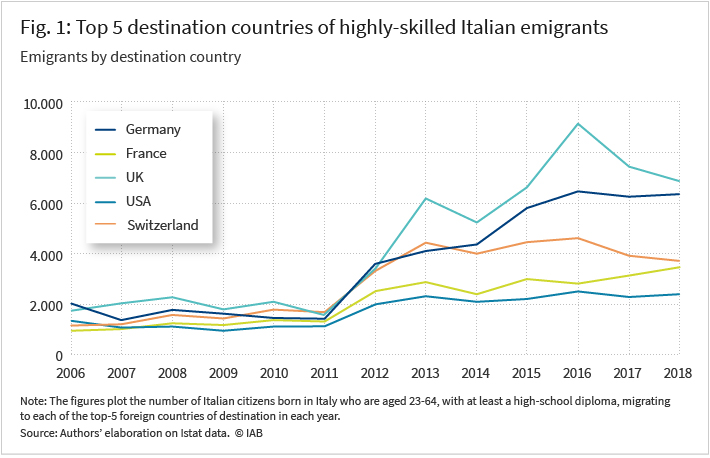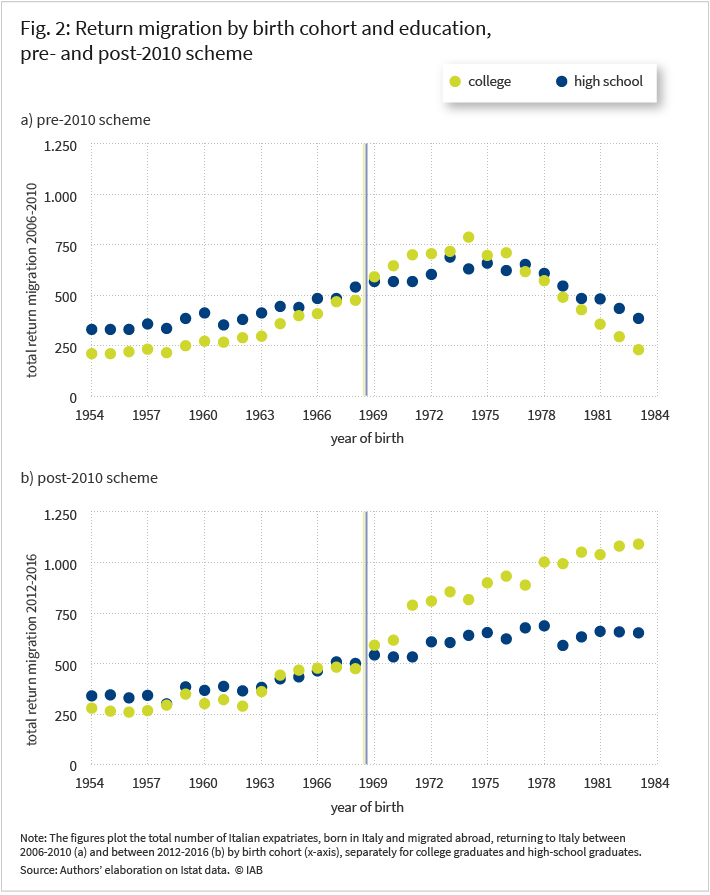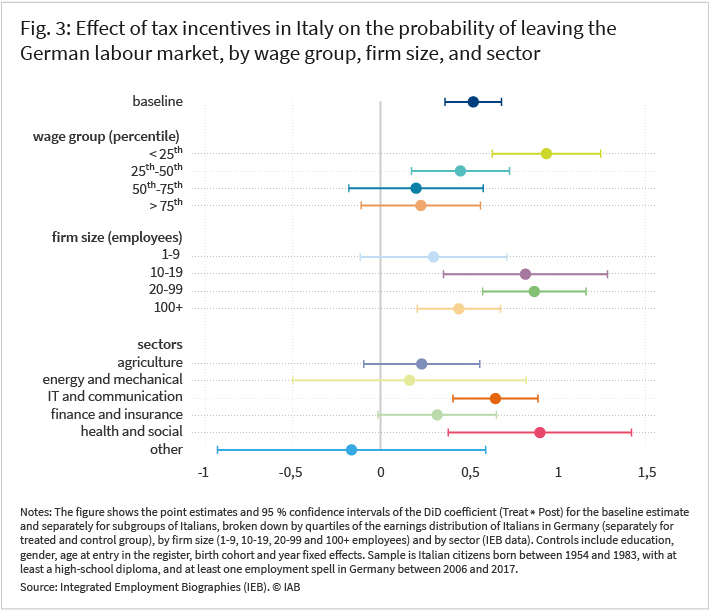28. November 2023 | International and Regional Labour Markets
Easy come, easy go: Return migration increases with tax incentives in the home country

The challenge of attracting and retaining highly-skilled workers
Attracting and retaining highly⎼skilled individuals is a top priority for most European countries. However, while some countries, such as southern European countries, are grappling with an ongoing “brain⎼drain”, other countries, such as Germany, face growing shortages in skilled labour and increasingly worry about attracting and retaining highly⎼skilled immigrants.
Several European countries have implemented preferential tax schemes targeting either highly⎼skilled foreigners or native emigrants with the goal of attracting them from abroad. For example, in 1991, Denmark introduced a preferential tax scheme that targeted high-earning foreign workers with a gross salary of at least 100 000 Euros per year. Under this scheme, the tax rate on labour earnings was reduced to a flat rate of around 30 percent for a period of up to three years. More recently, in 2012, the Netherlands enacted a preferential tax scheme to attract foreigners with a minimum salary of 35 000 Euros per year. Examples of tax schemes introduced by origin countries are the Portuguese tax incentives (2015) and the Italian “Legge Controesodo” (2010), whose policy evaluation is the focus of this article.
How do countries use tax schemes to influence the location choices of mobile workers? The economic literature shows that income differences between countries are a key determinant of migration and re-migration decisions (together with other monetary and non-monetary factors). Preferential tax schemes aim precisely at increasing the net income and consequently changing the net wage differentials between one country and others. In other words, lower income taxes in one country increase individual net income, making this country more attractive relative to the other countries. For example, if Germany were to implement a policy that reduced income taxes for immigrants who relocate to the German labour market, this policy would make any other destination country relatively less attractive in terms of monetary returns to migration compared to Germany. Similarly, preferential tax schemes implemented by origin countries make the home country more attractive for expatriate workers relative to the country the individuals are currently working in or a possible destination country.
Germany is one of the main destinations amongst Italian highly⎼skilled workers
Amongst the different tax schemes implemented by several European countries during the last decades, the Italian returnees’ tax scheme – whose characteristics we describe below – is particularly relevant for Germany. Starting from the Great Recession of 2009, Germany has become one of the leading destinations for highly⎼skilled Italians who increasingly chose Germany over other destinations such as the US and Switzerland. In the most recent reporting year, 2018, more than 6 000 highly⎼skilled emigrants have relocated to Germany, as Figure 1 shows. A policy that favours the return of highly⎼skilled Italian workers could attract a considerable number of skilled workers in Germany back to Italy, leading to sizeable effects on German firms and remaining workers.

Furthermore, the preferential Italian tax scheme may change the average labour⎼market trajectories of those who remain in Germany and those who, attracted by the tax incentives, decide to return to Italy. Two scenarios could be hypothesised: either higher earners are more likely to leave because of the larger tax savings in Italy, or lower earners are more likely to leave because they are underemployed or mismatched in the German labour market and can now earn similar wages in Italy. If the latter scenario prevails, the tax scheme may improve the average quality of matches between workers remaining in Germany and firms.
Understanding both the characteristics of the policy and its effects on the re-migration decisions of Italian immigrants is therefore relevant for German policy-makers, who may want to evaluate the relative attractiveness of the German labour market for Italian immigrants and consider counterbalancing measures.
The Italian returnees’ tax scheme targeted high-skilled, young Italians
In December 2010, Italy introduced the first preferential tax scheme for inbound workers with Law 238/2010 “Controesodo” (“counter-exodus”), which granted a generous income-tax reduction to Italian highly⎼skilled returnees and immigrants who had previously lived at least two years in Italy. Under the 2010 tax scheme, eligible individuals paid substantially reduced income taxes for up to 5 years: specifically, only 25 percent of their labour earnings was taxable, which translates to a 30 percentage⎼point reduction of their average and marginal income tax⎼rates. Two key eligibility⎼requirements were introduced: holding a college degree and being born on or after 1 January 1969.
The findings of Bassetto and Ippedico (2023) are summarised below. In their study, the above requirements were combined with detailed register data on return migration and on the group of Italian workers registered in Germany (see Infobox), in order to understand to what extent the tax incentives induced the return⎼migration of highly⎼skilled migrants from Germany to Italy.
European countries are losing Italian highly⎼skilled workers, who are attracted back home by tax incentives
First, analyses based on Italian register data show that the introduction of the tax incentives led to a substantial increase in return migration of young and highly⎼skilled Italian expatriates eligible for the scheme. Figure 2 shows the number of returnees from any host country by birth cohort and education under the pre-2010 scheme (graph a) and the post-2010 scheme (graph b). Upon the introduction of the preferential tax scheme (graph b), the number of returnees from abroad increased for all cohorts in the eligible group of highly⎼skilled migrants (with a college degree) born after 1968 (right-hand side of the vertical line). Accordingly, the return rates of eligible Italians increased on average by 27 percent – around 2000 individuals per year – in the years after the reform, compared to non-eligible Italians. This increase in return migration is mainly driven by Italians returning from other European countries, especially Germany, but also the UK and Switzerland.

Second, when the focus is placed on the German labour market and the probability of leaving based on the pool of Italian workers in the German register data is estimated, remarkably similar results are produced, consistent with an increase in return migration of eligible Italians working abroad. Young, highly⎼skilled Italians working in Germany are more likely to leave the German labour market after the introduction of tax incentives, as the wages they earn back in Italy are closer to the wages earned in Germany. The introduction of the Italian tax incentives increases the probability of leaving the German labour market by 0.5 percentage points (see Figure 3). This increase corresponds to a 21 percent increase relative to the pre-reform period.
Further, more detailed analyses reveal that the tax incentives introduced by the Italian government had varying effects on different groups of Italians working in Germany (see Figure 3). The tax reform was especially effective in increasing the return migration of Italians in Germany working in small⎼ and medium⎼sized firms (with 10⎼19 employees and 20⎼99 employees) and in skills-intensive sectors such as IT and communications, as well as in the healthcare sector. Additionally, emigrants in Germany with relatively low wages (lower quartile – 25th percentile – of the wage distribution) were more likely to return to Italy. This finding is consistent with the hypothesis that the tax incentives attracted those workers back to Italy who were underemployed and mismatched in the German labour market or other destination countries.

Conclusion
In view of the shortage of skilled workers, some European countries have introduced preferential tax schemes to attract highly⎼skilled workers. Whereas destination countries use tax incentives to increase the number of highly⎼skilled immigrants, origin countries try to reduce their highly⎼skilled outflows by incentivising return migration.
The Italian returnees’ tax scheme “Legge Controesodo” (2010) increased the number of highly⎼skilled Italians returning to Italy, while it decreased the number of highly⎼skilled Italians in the German labour market. The finding of differential effects on different worker groups reveals that the tax reform also changed the selection of those Italians who remain in Germany, as Italians who do not return because of the law have relatively higher earnings. They are possibly better matched to German firms and, therefore, more attached to the German labour market.
Moreover, while no increase in emigration from Italy in response to the tax schemes was observed, the reform could increase the number of highly-skilled workers considering to relocate to Germany or other destinations so to become eligible for the tax incentives upon their return to Italy. It is likely that at least some of them would stay in their destination country. Finally, as the incentives are temporary, it could be that those who returned to Italy will eventually move back to Germany or other European countries bringing with them novel skills and broader networks.
The effects of the Italian returnees’ tax scheme on the return migration of Italians working abroad show that the German government and other destination countries should pay close attention to the tax incentives introduced by other countries – both other destination countries and origin countries. While Germany is strongly interested in attracting new highly⎼skilled migrants to reduce domestic skills shortages in key occupations, it should also consider policies to retain them. Even more so if origin countries start to offer tax discounts and other incentives to return. Therefore, German employers and employers in other destination countries should invest in improving the quality of immigrants’ experience through better workplace environments, creating more flexibility and offering better career opportunities.
From a global perspective, the introduction of tax incentives to increase return migration is a strong reminder that while highly⎼skilled migration may benefit Germany and other destination countries, brain-drain phenomena – like those experienced by southern European countries – may have detrimental effects on the societies and economies of origin countries. Hence, governments should be aware that the competition for talent has both winners and losers, benefits and costs. The latter may rise if countries engage in a race to the bottom. A more desirable solution from a global perspective would be promoting fair competition for high-skilled workers by creating a more continuous and homogeneous exchange of talent as well as international networks, where the benefits of highly⎼skilled workers are shared amongst countries.
Information box – The study design
Two eligibility requirements were combined, education and date of birth, to calculate differences between eligible and non-eligible Italian emigrant groups before and after the reform (difference-in-differences strategy). The eligible group ⎼ Italians working abroad, holding a college degree (at least a 3⎼year degree), and born on or after 1 January 1969 ⎼ has access to the new returnees’ tax scheme from 2011 onwards, while all other Italian emigrants are not affected by the new tax law.
To make the comparison group as similar to the eligible group as possible, only college graduates born before 1 January 1969, and high-school graduates born on or after 1 January 1969 were included.
To better show the effects of the tax scheme on the return decision of high-skilled workers, two complementary perspectives were taken. First, detailed Italian migration statistics from the Italian Statistical Office (Istat) were used to investigate the effects of the tax scheme on the return migration rates of Italian workers independent of the destination country.
Second, the employment histories of the pool of Italian workers in Germany (data provided by the Institute for Employment Research) were used to investigate the effects of the tax scheme on the probability that eligible Italian workers would leave the German labour market. Given the individual-level and precise data on wages, firms, and occupations, the German social security records also allowed an exploration of the differential effects of the tax scheme on various groups of Italian workers.
References
Two eligibility requirements were combined, education and date of birth, to calculate differences between eligible and non-eligible Italian emigrant groups before and after the reform (difference-in-differences strategy). The eligible group ⎼ Italians working abroad, holding a college degree (at least a 3⎼year degree), and born on or after 1 January 1969 ⎼ has access to the new returnees’ tax scheme from 2011 onwards, while all other Italian emigrants are not affected by the new tax law.
To make the comparison group as similar to the eligible group as possible, only college graduates born before 1 January 1969, and high-school graduates born on or after 1 January 1969 were included.
To better show the effects of the tax scheme on the return decision of high-skilled workers, two complementary perspectives were taken. First, detailed Italian migration statistics from the Italian Statistical Office (Istat) were used to investigate the effects of the tax scheme on the return migration rates of Italian workers independent of the destination country.
Second, the employment histories of the pool of Italian workers in Germany (data provided by the Institute for Employment Research) were used to investigate the effects of the tax scheme on the probability that eligible Italian workers would leave the German labour market. Given the individual-level and precise data on wages, firms, and occupations, the German social security records also allowed an exploration of the differential effects of the tax scheme on various groups of Italian workers.
Agrawal, David R., and Dick Foremny. 2019. “Relocation of the Rich: Migration in Response to Top Tax Rate Changes from Spanish Reforms.” Review of Economics and Statistics 101(2): 214–232.
Akcigit, Ufuk, John Grigsby, Tom Nicholas, and Stefanie Stantcheva. 2022. “Taxation and Innovation in the Twentieth Century.” The Quarterly Journal of Economics 137 (1): 329–385.
Anelli, Massimo, Gaetano Basso, Giuseppe Ippedico, and Giovanni Peri. 2023. “Emigration and Entrepreneurial Drain.” Forthcoming, American Economic Journal: Applied Economics
Bassetto, J., & Ippedico, G. (2023). Can Tax Incentives Bring Brains Back? Returnees Tax Schemes and High-Skilled Migration in Italy. CESifo Working Paper No. 10271
Bijwaard, Govert E, Christian Schluter, and Jackline Wahba. 2014. “The impact of labor market dynamics on the return migration of immigrants.” Review of Economics and Statistics 96 (3): 483–494
Dustmann, Christian. 2003. “Return migration, wage differentials, and the optimal migration duration.” European Economic Review 47 (2): 353–369.
Dustmann, Christian, and Joseph-Simon Görlach. 2016a. “The economics of temporary migrations.” Journal of Economic Literature 54 (1): 98–136.
Kleven, Henrik J., Camille Landais, Emmanuel Saez, and Esben Schultz. 2014. “Migration and wage effects of taxing top earners: Evidence from the foreigners’ tax scheme in Denmark.” The Quarterly Journal of Economics 129 (1): 333–378.
Schmidheiny, Kurt, and Michaela Slotwinski. 2018. “Tax-induced mobility: Evidence from a foreigners’ tax scheme in Switzerland.” Journal of Public Economics 167: 293–324
Picture: Alina Rosanova/stock.adobe.com
DOI: 10.48720/IAB.FOO.20231128.01
Bassetto, Jacopo; Ippedico, Guiseppe (2023): Easy come, easy go: Return migration increases with tax incentives in the home country, In: IAB-Forum 28th of November 2023, https://www.iab-forum.de/en/easy-come-easy-go-return-migration-increases-with-tax-incentives-in-the-home-country/, Retrieved: 28th of April 2024
Authors:
- Jacopo Bassetto
- Guiseppe Ippedico

 Jacopo Bassetto is a Researcher at the Department of Statistics of the University of Bologna and Research Fellow at the Institute for Employment Research.
Jacopo Bassetto is a Researcher at the Department of Statistics of the University of Bologna and Research Fellow at the Institute for Employment Research. Giuseppe Ippedico is an Assistant Professor in the School of Economics at the University of Nottingham and a Research Affiliate at IZA (Institute for Labor Economics).
Giuseppe Ippedico is an Assistant Professor in the School of Economics at the University of Nottingham and a Research Affiliate at IZA (Institute for Labor Economics).